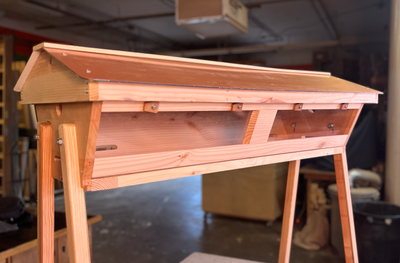Swarming and Swarm Removal
Why do Honeybees Swarm?
Swarms are the method by which honey bee colonies reproduce. 20-50% of the colony leaves the hive with the old queen, landing within a couple hundred feet of the hive they left from. They usually end up on tree branches, but sometimes they'll decide to land elsewhere, such as on mailboxes, cars, fences, door handles or anything else you can think of. This is only temporary, though, as the colony sends out scouts to find a new, permanent home. This is often a tree cavity, but any sufficiently large and dry cavity is suitable. Honey bees often choose wall cavities in houses because they are safe, dry places in which they can thrive.
Although a "swarm of bees" sounds a bit scary, they are usually completely docile and uninterested in stinging you or your family while swarming. The bees just want to find a new home. Many beekeepers prefer to fill their hives with swarms and go to great effort catching them. Swarms from untended or "feral" colonies of bees often have strong genetics, resistance to parasites, and require little human assistance to thrive. Even better, they’re usually free!
How to identify a honeybee swarm:
Other insects a like wasps, yellow jackets, and bumble bees are often mistaken for honeybees. A swarm of honeybees have a few distinct features you can look out for. Individual bees have fuzzy black and gold bodies, and the swarm overall will appear as a distinctive, hanging clump. This clumping behavior makes it possible for beekeepers to gently collect and transport the bees.
Who to call:
In Portland, Portland Urban Beekeepers is Portland's local beekeeping association. They maintain an online reporting system. The system will notify local beekeepers , once one accepts the swarm notification they will contact you to arrange when to collect your swarm without harming the bees. They’ll install the bees into one of their hives and give them a safe home. If the swarm is too high for the beekeeper to safely reach then you can wait until the bees move along on their own. You can find their reporting system here.
Around the United States, simply search the internet for your city and terms such as "honeybee removal," or "honeybee swarm removal." Many beekeepers want your swarm. If you call a pest company, ensure that they will be calling a beekeeper to remove the swarm rather than spraying the swarm and killing it with pesticides. Most reputable pest companies are referring callers to beekeepers.
Structural Removal:
If you have honeybees living inside you home or other structure, there's still a chance to save the bees! Some beekeepers are also licensed and bonded contractors who can open the building cavity and remove the bees. Simply search the internet for your city's name, and "honeybee structural removal."







